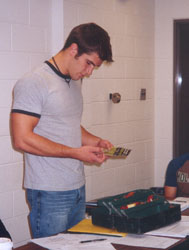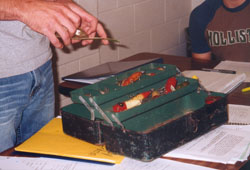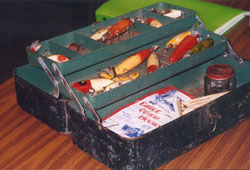
Home
- Artifacts
- Buildings & Businesses
- Churches
- Holidays & Celebrations
- Counties/Locations
- Delta College
- Early Settlers
- Ethnic Background
- Local, Michigan, U.S. and World Events
- Family Genealogy
- Farming
- Libraries & Museums
- Local Sites
- Logging
- Musicians, Artists & Famous People
- Nature, Weather & Four Seasons
- Railroads
- Schools
- Sports
 |
As I look at my Great Grandpa Erdman's old tackle box, I wonder what kind of memories it holds. He used to fish on the St. Clare River, near Port Huron, and I will always wonder what it would have been like to hop in his boat and go fishing with him. He would have been the true portrait of a farmer in his bibbed overalls and heavy work boots, smoking his Lucky Strikes unfiltered cigarettes and carrying his tackle box.
The tackle box has been passed down through the years and makes no attempt to hide its
age. Grandpa would have begun using it in 1930's, but it still serves its purpose well. The hooks inside have long since been put into retirement, and the lures seem more like museum artifacts than fish bait. However, as long as the memories remain, so will the box--as a cherished reminder of my great grandpa.
The old metal tackle box is nothing fancy, and if I saw it at a garage sale I would walk by without giving it a second glance. The black paint has chipped to green paint underneath, and the green paint is chipped and scratched right down to rust. It looks like an old lunch box, except for the one foot measurement on the front used to measure fish; it sits thirteen inches by six inches and about seven inches deep. With all its baggage of hooks, lures and other fishing devices, it weighs about seven pounds, and it also has a smooth metal handle in the shape of a rectangle on top. On the front, in the very center, is a latch to keep it closed.
As I open the scarcely-greased lid, I can hear the lures rattling inside. The lid pulls back two small green trays full of different types of lures. Once open, it leaves a small compartment on the bottom to store other various objects and lures. The top tray is divided into five different sections, leaving the middle section twice as large as the four on the outside.
 |
The lures on the inside of the bin look nothing like the ones that I am used to using, but after taking in all the evidence they must have worked. My great grandpa was known in our family to have a knack for catching fish, and if I look at a lot of his lures they have scars from their former battles with pike and walleye. There are many wooden lures, which to me look more like monstrosities put in the water to snag a fish as opposed to getting them to bite it. The one lure that really caught my eye looks more like the predator than the prey. It is about five inches long and equipped with two eyes resembling a small fish. It also has two spinners or propellers, and five treble hooks, which is fifteen prongs, three to each treble hook. I can picture my grandpa frustrated and fumbling around with this lure, because it hooks at least one extra lure ever time I try to get it out of the tackle box, and leaves me with a small tangled mess. There are a few lures that you will still see today, probably modified, but with the same basic design, such as the jitterbug or the flat fish. Another interesting lure that you may still see today is the weedless lure, which has a guard over its two treble hooks to make sure the user didn't snag any weeds while fishing.
The bottom compartment of the tackle box is full of various objects and a different type of lure called a spoon, a lure that is made in an elongated oval shape. It usually has gold or silver on the back, and some type of design on the front, depending on what type of spoon it is. Spoons generally have a treble hook on the bottom, and most often come in a size of two to six inches long. The spoons are mostly daredevils in this tackle box, a type of spoon with one wavy stripe down the middle. There is also an object called a deptherm, which is used to tell the temperature at certain depths by having a thermometer on one side and depth on the other. The depth was found by attaching a fish line to the top of the device and lowering it to a certain depth; the growing pressure forces water into a tube, and the volume of water trapped in the tube serves as a measurement.
 |
Recently, the old green tackle box was passed down to my father, and I'm sure it will continue to be passed down for years to come. It will be a reminder of my family history that I will only know through the pictures, stories and belongings my family members leave behind.
| The written and visual works in Mid-Michigan Remembers-Stories about Us were chosen on the basis of their quality, diversity, community interest and appeal. Views expressed do not necessarily reflect those of the College. This space is provided as a service by Delta College. |